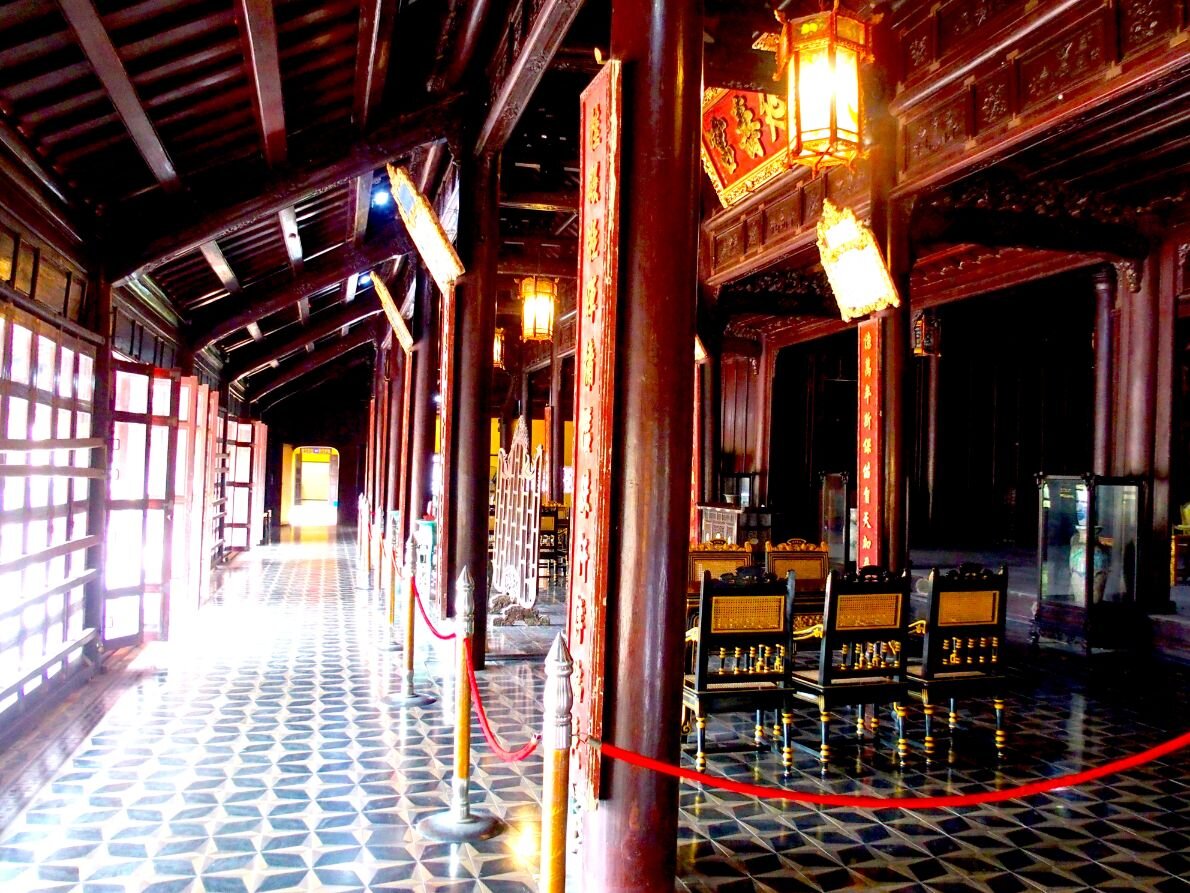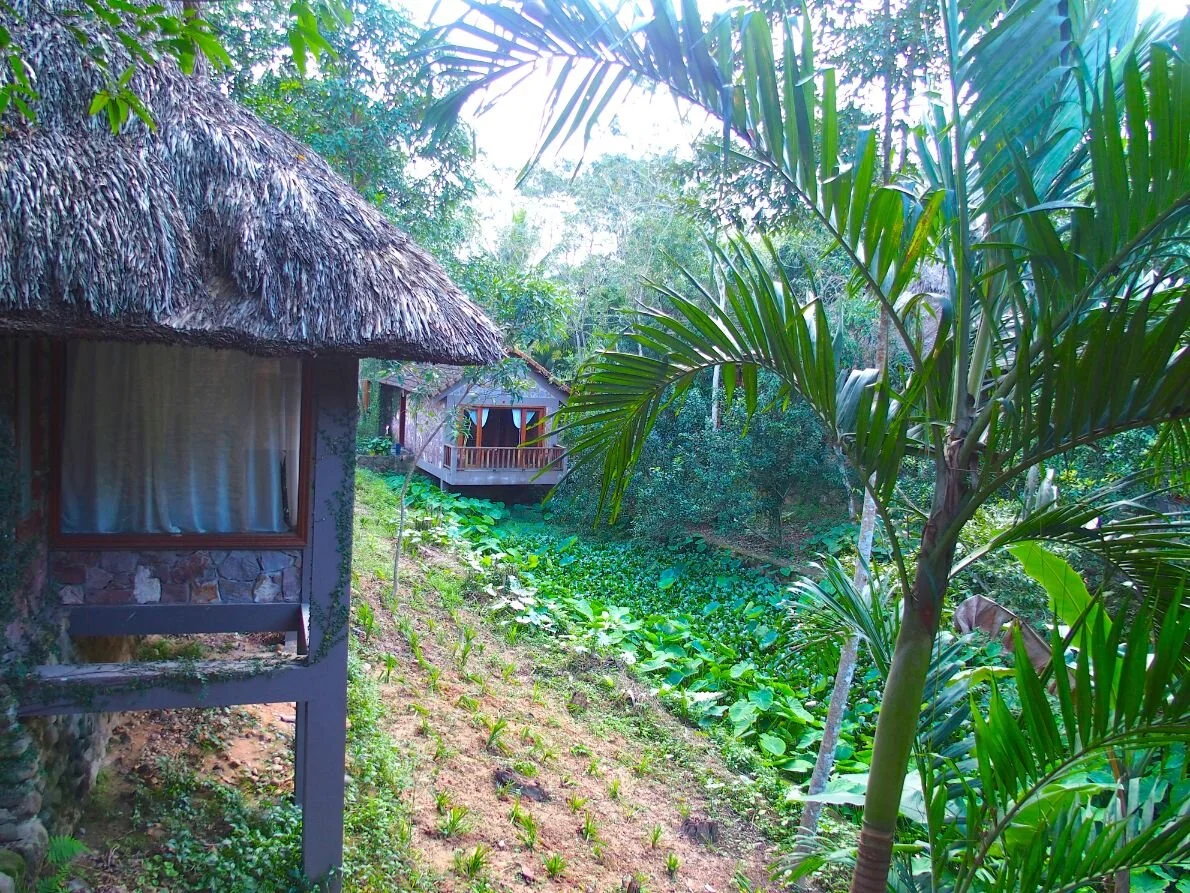We awake to a heavily overcast sky. The tropical weather of southern Vietnam doesn’t quite reach to the central parts of the country, and there’s a distinct nip in the air as we eat breakfast by a lily-pond pool, before taking a stroll through the beautiful grounds of the Pilgrimage Village resort.
Breakfast terrace
We arrive a few minutes late to the lobby for our guide, a distinctly unimpressed Hyung. But we soon discover the dismissive air of perpetual annoyance is in fact her default setting, so strap ourselves in for a day of huffs and puffs as Hyung tries to corral us around to her specific timetable, which we keep throwing out of whack by stopping to take photos or attempt to view things of interest which she deems unimportant.
Our first stop is at the Tomb of Emperor Tu Doc, the second ruler of Vietnam, which is located fairly close to our hotel. The city of Hué is surrounded by ornate tombs of many of its former emperors, all of which are very different in style and size from each other. Tu Doc’s is apparently the must-see of them all and it doesn’t disappoint.
A vast parkland that houses an ornamental lake, woodlands and buildings for his wives, concubines, courtiers and more, Tu Doc moved here to experience heaven on earth before he died. We cross a bridge over to his mausoleum, where ancient Vietnamese inscriptions in the Chinese script extol his virtues. I ask Hyung what they mean and she shrugs her shoulders and says no-one reads the old script anymore, since Ho Chi Minh westernised the alphabet. “Isn’t there a transcription?” I ask. She looks at me like she’s chewing a wasp.
Emperor Tu Doc’s tomb
We escape her beady gaze for a quick wander around his actual tomb and then I spy an interesting building up a little hill a bit further on. Hyung insists we don’t have time to visit it, despite it being less than a two minute walk away. Coman and I disappoint her even further by hurrying over to it anyway for a quick look, taking photos of its dragon-carved stairs, before allowing her to shepherd us back to the car.
We drive into the centre of Hué, where the Imperial City awaits, one of the jewels in Vietnam’s history, which was also the scene of some of the most notorious fighting in the Vietnam war – a month of combat known as the Tet Offensive, made famous by the Stanley Kubrick film ‘Full Metal Jacket’.
The citadel sits on the banks of the Perfume River and we are dropped off with Hyung at the south entrance by the Ngo Mon Gate, more commonly known as the Noon Gate. She launches into a long-winded description of its history, which I’ve already read extensively about, before allowing us to progress into the Imperial city. Overhead the clouds are thick and dark giving a foreboding sense to the whole panorama ahead of us which opens out into a spectacular square.
Outside the Noon Gate
In front us lies the Thai Hoa or Palace of Supreme Harmony, surrounded by bare frangipani trees, their leaves and blossoms waiting for winter to end and spring to bloom. Before we enter the palace to view its huge and ornate interior, we cross the large courtyard where officials would gather to hear the King’s proclamations. He would remain inside so he could not be attacked, with an official relating his words to the courtiers and passing their requests back.
After marvelling at the fabulous throne, and obeying the strict instructions not to take photos, we continue on to the Queen Mother House, known as the Dien Tho Residence. To get there we wander past ruined buildings awaiting restoration, viewing fields that used to be rice paddies to feed the Imperial family, and areas where cavalry and elephant-riding guards would gather to escort the emperor when he wanted to leave the Citadel and interact with his subjects.
Inside the Queen Mother house are portraits of Imperial families, including photos of the final generations leading up to the 13th and final Emperor, who eventually signed over all control of Vietnam to his French colonial masters and left for Europe. Further rooms include antique furniture and at the back of the house is a lovely pleasure pavilion where female members of the family would gather for tea, out of the gaze of the men.
Emperor’s Reading Room
Our next stop is known as the Forbidden Purple City. This area was for the sole use of the Emperor and housed his Harem of concubines. Eunuchs could accompany him in and serve him when required but for the most part it was a realm of total privacy where the Emperor could indulge his every whim. The Forbidden City was almost fully destroyed during the Tet Offensive but is in the process of being renovated, using old American aerial photos from the war alongside its restorers’ imaginations, as no photos were ever taken while it was in use - to ensure that none of the antics going on were ever recorded. Rather like Soho House today!
We continue through the Emperor’s Reading Room, the Temple of Literature, and the Royal Theatre, all of which have been restored to former glories, although Hyung sniffily tells us that the Theatre never actually looked as it does now and is far too embellished. It is pretty swish, and gives an indication of the potential for the dilapidated Royal Treasury across the pathway as and when it gets its makeover.
We exit the Imperial City through the Gentleman’s Gate and are due to be returned to the Pilgrimage Village for the afternoon. However there’s still so much to see that I manage to persuade Hyung to drop us off on the banks of the Perfume River where we charter a dragon boat to cruise us thirty minutes upstream to the Thien Mu Pagoda.
Our dragon boat
The boat is a family run affair with the skipper, his wife and their baby daughter all living and working aboard in basic conditions. The wife continually, and very sweetly, tries to sell us trinkets and souvenirs, none of which we really want but we buy drinks and little magnets, as well as giving them a substantial tip on our return to the city.
The Thien Mu Pagoda itself is well worth the trip, a seven-tier building surrounded by statues and tranquil gardens through which monks wander and tourists with selfie sticks crowd around. One of the most interesting exhibits is the car which Buddhist monk Thích Quảng Đức travelled in to Saigon before he burned himself to death on 11 June 1963. Quảng Đức was protesting against the persecution of Buddhists by the South Vietnamese government led by Ngô Đình Diệm and photographs of his self-immolation were circulated widely around the world winning Malcolm Brown a Pulitzer prize for his famous portrait of the monk calmly on fire.
We’re absolutely ravenous by the time we return to Hué and have 45 minutes to kill before we can jump in a free shuttle back to Pilgrimage Village so find a little street café called Hot Tuna where we get a very cheap and delicious lunch of noodles, salad and beer. The shuttle arrives on time and transports us through the town, which is a much calmer, more affluent, cleaner and upmarket city than any we’ve seen so far on our trip.
Lunch at Hot Tuna
Expensive hotels, restaurants and coffee shops abound, with more developed streets and civic infrastructure on display. The fact that the city comprises only 400,000 people as opposed to the likes of Ho Chi Minh City’s 11 million population means there’s far less litter, traffic and pollution than many south-east Asian cities.
At the hotel we make our way down to the vast and very glamorous pool where we enjoy a cocktail and a very chilly swim under the gloomy skies, warming ourselves up with a bath in the enormous wet room of our bungalow. However we decide to leave the environs of Pilgrimage Village and head back into Hué for dinner, partly because the city is renowned as the culinary capital of Vietnam with a distinct cuisine and fantastic restaurants, and partly because the hotel restaurant boasts prices that would shame a fine-dining London establishment.
Back in town we wander streets for a while, passing bars and restaurants full of tourists and back packers, checking out art exhibitions and buying a few little souvenirs from vendors on the streets, before settling on Hoa Viên restaurant which has an extensive vegetarian menu. Its aubergine clay pot and spicily fragrant tofu dishes are both utterly delicious and a fraction of the cost of a portion of plain rice back at the hotel.
Monk at Thien Mu Pagoda
As we continue our stroll through Hué’s nightlife we pass people burning fake money for the lunar new year and full moon. Next to the shuttle bus stop is a three storey bar called Vinh Lee Tién, which is bedecked in lanterns, strung out in glowing multi-colours, and pumping out music, so we grab a couple of bottles of ridiculously cheap local beer and watch the world go by until we see the Pilgrimage Village bus pull into view.
Hué has proved to be a fascinating and exciting town, and we’ll be sad to leave, especially as there’s so much more to explore, so when we get back to the hotel we ask the reception staff to book us an early morning taxi to visit another Emperor’s tomb, which has come highly recommended. We want to get one last sight in before we drive south to one of the most photographed and picturesque towns in the whole of Asia – the fabulous Hoi An!



































